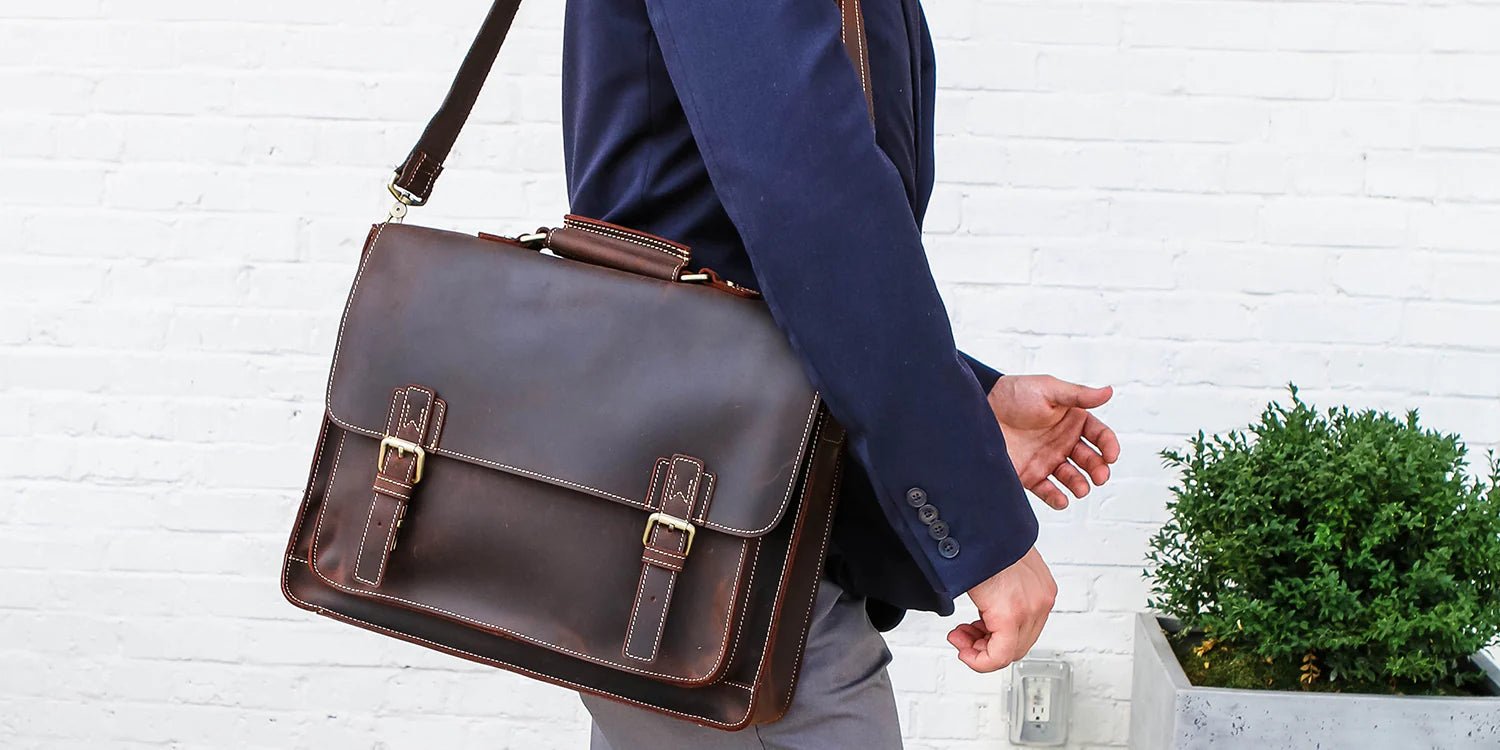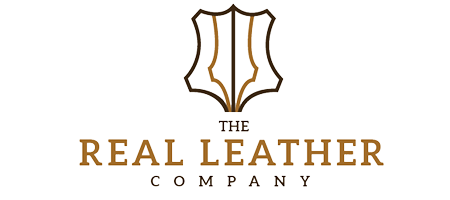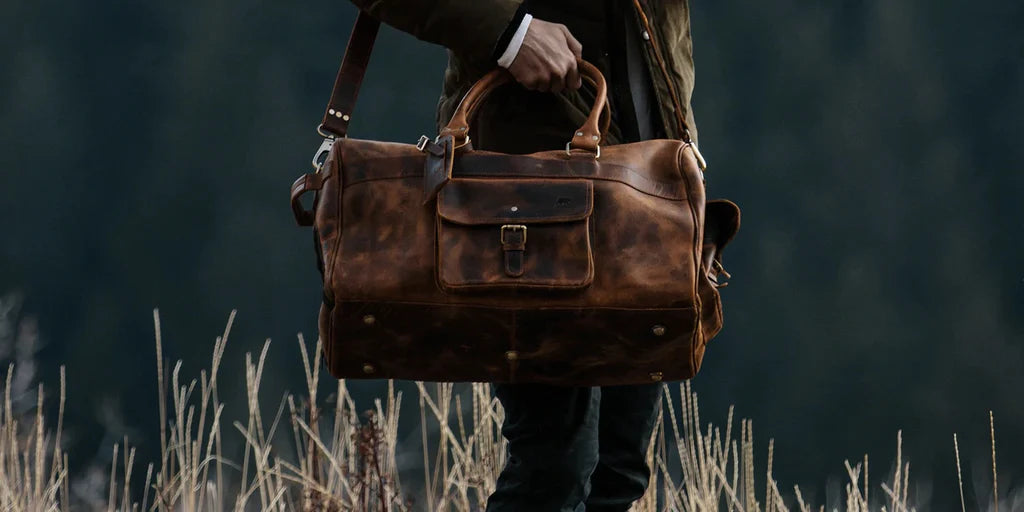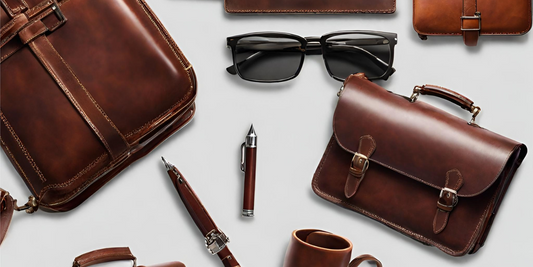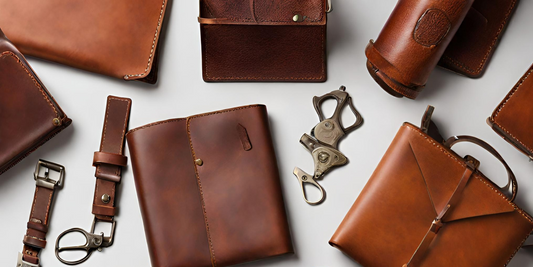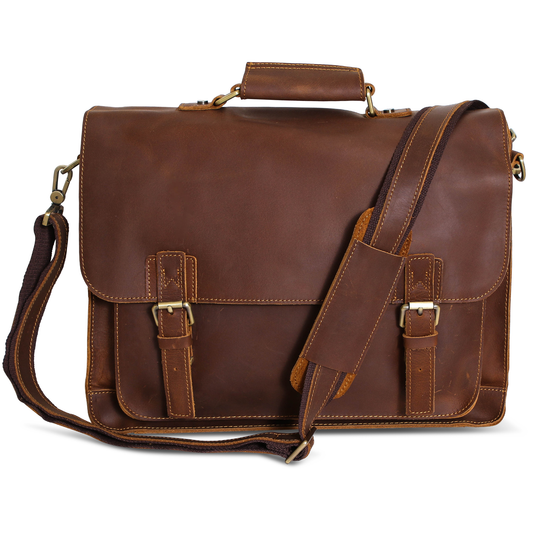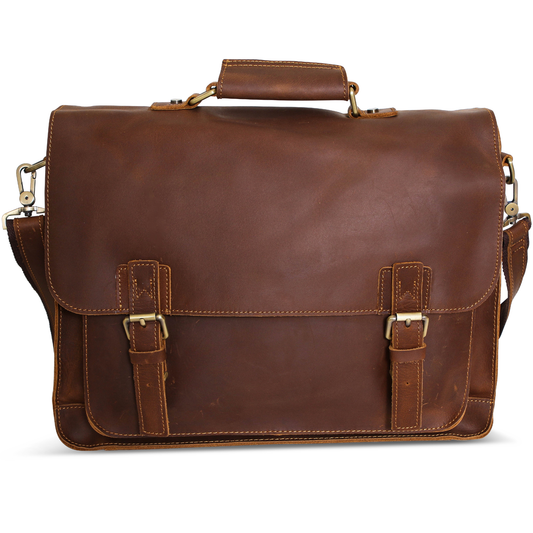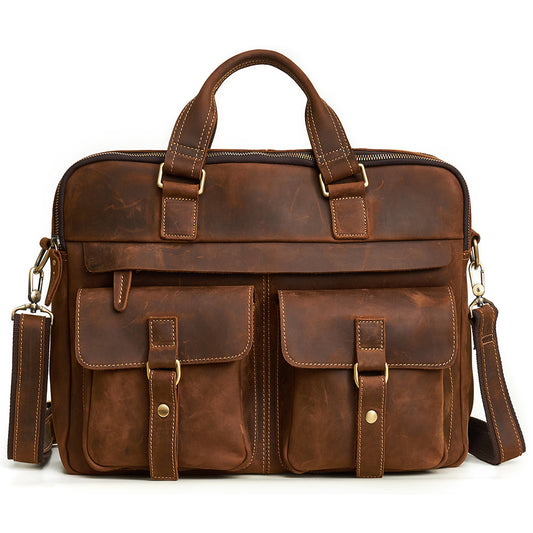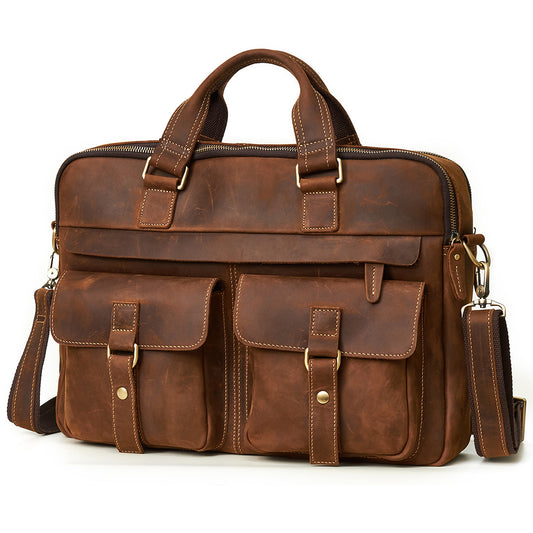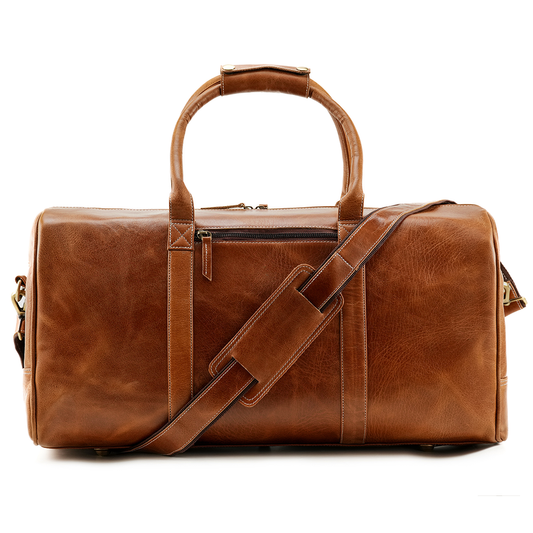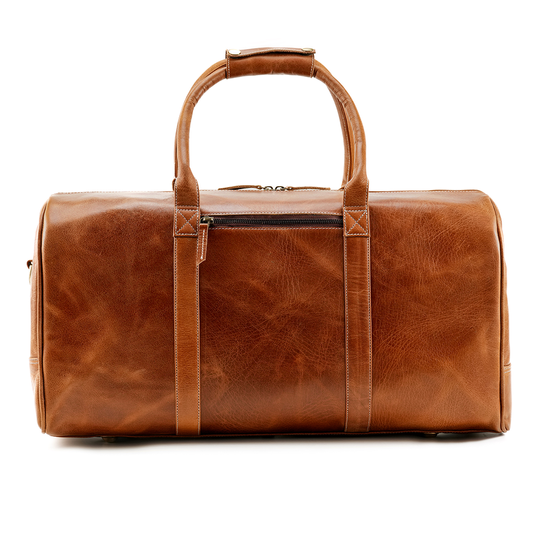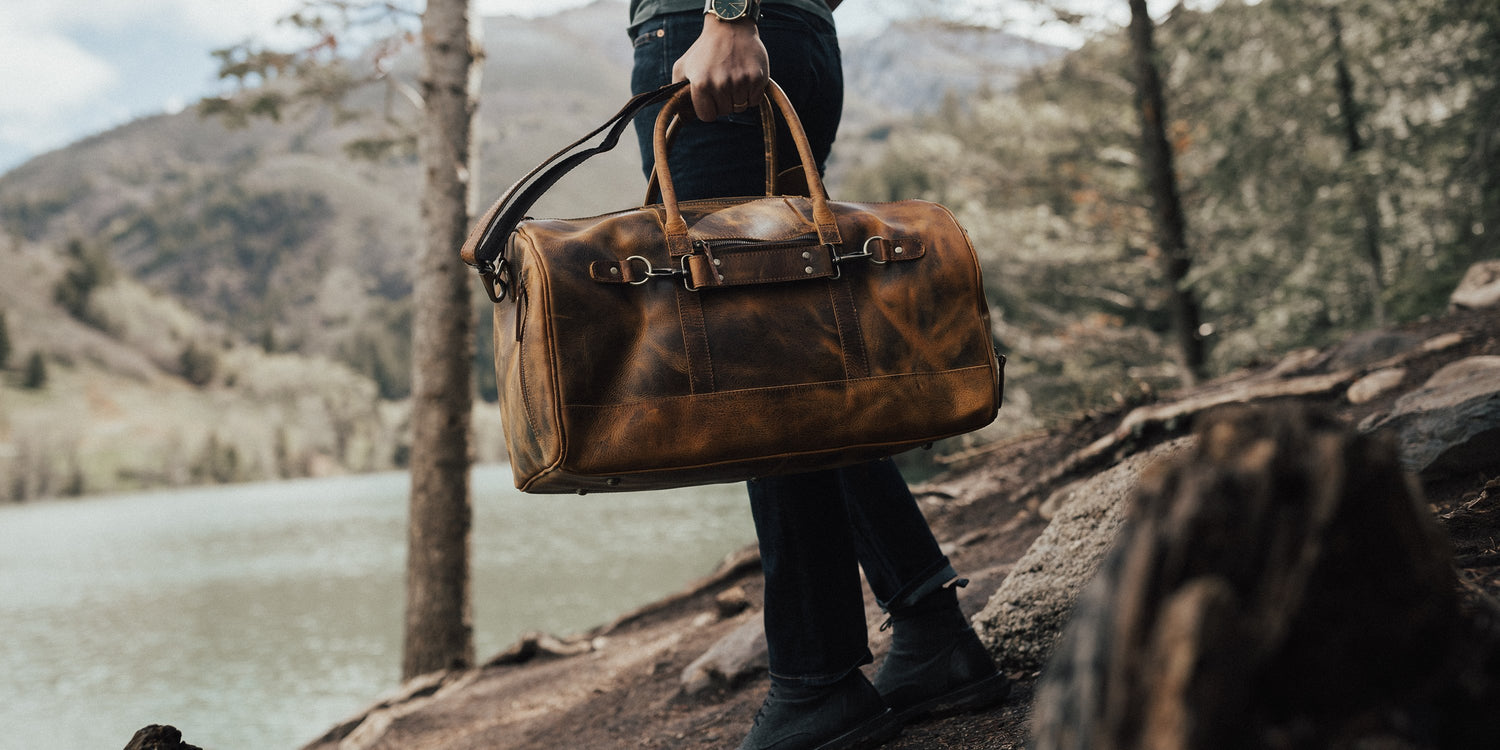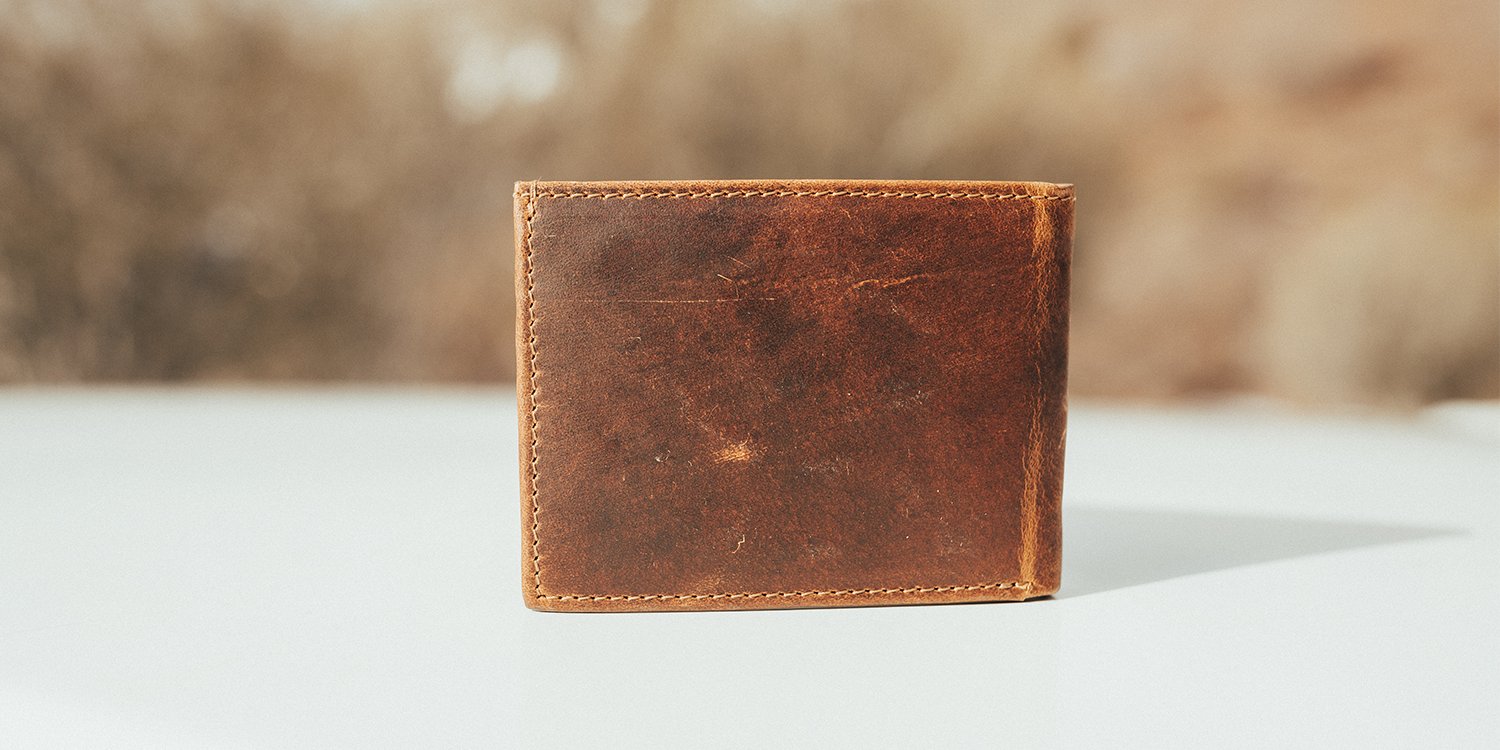Shopping online for fine leather goods can be confusing.
在网上购买精美的皮具可能会令人困惑。
You'll see phrases like "full grain", "top grain," and "genuine" used to describe leather.
您会看到用于描述皮革的“全粒面”、“顶级粒面”和“正品”等短语。
But what do these terms mean?
但这些术语是什么意思呢?
This is a complete guide to full grain leather.
这是一本完整的全粒面皮革指南。
This article provides comprehensive definitions, pros and cons, a care guide and comparisons to both top grain and genuine leather.
本文提供了全面的定义、优缺点、护理指南以及与顶级粒面和真皮的比较。
Ready to dive into the world of full grain leather?
准备好潜入全粒面皮革的世界了吗?
Let’s uncover its secrets and why we use it for many of our leather bags.
让我们揭开它的秘密,以及为什么我们用它来制作我们的许多皮包。
What is Full Grain Leather?
什么是全粒面皮革?
Full grain leather is the strongest and most durable grade of leather available. It retains the maximum thickness, oil absorption, and natural grains from the original outer layer of the animal hide. Unlike other grades, no sanding or chemical treatments are applied before entering the tanning process.
全粒面皮革是最坚固、最耐用的皮革等级。它保留了动物皮原始外层的最大厚度、吸油性和天然颗粒。与其他牌号不同,在进入鞣制过程之前不进行打磨或化学处理。

Should I Choose Full Grain Leather?
我应该选择全粒面皮革吗?
Full grain leather is an extremely sturdy material that has a distinct appeal to many who choose to buy real leather goods.
全粒面皮革是一种非常坚固的材料,对许多选择购买真皮制品的人具有独特的吸引力。
However, we appreciate that it may not be right choice for everyone.
但是,我们理解它可能不是每个人的正确选择。
In many cases, we recommend top grain leather instead.
在许多情况下,我们建议改用顶级粒面皮革。
Let’s take a closer look at the properties of full grain leather, its pros and cons and full grain vs other grades.
让我们仔细看看全粒面皮革的特性、优缺点以及全粒面与其他等级的对比。

Pros of Full Grain Leather
全粒面皮革的优点
1. Durability 1.耐久性
The biggest advantage of using full grain leather is its durability.
使用全粒面皮革的最大优点是耐用性。
And if you really think about it, this durability makes total sense.
如果你真的想一想,这种耐用性是完全有道理的。
Full grain leather is the closest you can get to the original raw animal hide.
全粒面皮革是最接近原始动物皮的皮革。
During an animal's natural life, its hide has endured extreme weather, attacks by bugs and fighting in their herds.
在动物的自然生活中,它的皮毛经历了极端天气、虫子的攻击和牛群的战斗。
It’s unlikely your leather good will have to endure these kinds of attacks, but it’s nice to know it could.
您的皮革制品不太可能必须承受这些攻击,但很高兴知道它可以。
Because the full thickness of the hide is used and the natural grains are retained, this makes full grain leather the perfect material for heavy-duty items like full-grain leather bags and belts.
由于使用了皮革的全厚度并保留了天然纹理,这使得全粒面皮革成为全粒面皮革包和皮带等重型物品的完美材料。

2. It Looks Better with Age
2.随着年龄的增长,它看起来更好
The beautiful, natural appearance of full grain leather will also appeal to those who love classic, high-quality goods.
全粒面皮革美丽、自然的外观也将吸引那些喜欢经典、高品质商品的人。
For those familiar with full grain leather, it is very easy to spot.
对于那些熟悉全粒面皮革的人来说,它很容易被发现。
We love that over time, your full grain leather develops a patina.
我们喜欢随着时间的流逝,您的全粒面皮革会形成铜绿。
A patina is essentially a soft sheen that develops through use.
铜绿本质上是一种通过使用而产生的柔和光泽。
The leather will typically start to look fuller, richer and the grain will become more prominent as the patina develops.
随着铜绿的发展,皮革通常会开始看起来更饱满、更丰富,纹理会变得更加突出。
We like to think a patina provides character and makes your leather good unique.
我们喜欢认为铜绿可以提供个性,并使您的皮革独一无二。
At The Real Leather Company, we are big fans of the patina effect on leather goods.
在The Real Leather Company,我们是皮革制品上铜绿效果的忠实粉丝。
We believe that this makes full grain leather look better with age.
我们相信,随着年龄的增长,这将使全粒面皮革看起来更好。
Take a look at this picture of the same full grain leather wallet, before and after a patina developed.
看看这张图片,同样的全粒面皮革钱包,在铜绿发展之前和之后。

Image credit: leatherneo.com
图片来源:leatherneo.com
3. Built to Last 3. 经久耐用
Full grain leather is built to last.
全粒面皮革经久耐用。
As it is the most durable, natural and strongest type of leather you can buy, it will usually outlast other types of leather by years.
由于它是您可以买到的最耐用、最天然和最坚固的皮革类型,因此它通常比其他类型的皮革更耐用。
A good full grain leather bag will often last for decades if well maintained (more on maintenance later)
如果维护得当,一个好的全粒面皮包通常可以使用数十年(稍后会详细介绍维护)
4. Water Resistance 4.防水性
Full grain leather is more water-resistant than other leathers.
全粒面皮革比其他皮革更防水。
This is because the original oil absorption characteristics of the hide have not been sanded away like in top grain or genuine leather.
这是因为皮革的原始吸油特性没有像顶级纹理或真皮那样被打磨掉。
The original animal hide had to be water-resistant to allow the animal to survive in extreme weather conditions.
原始的动物皮必须具有防水性,才能使动物在极端天气条件下生存。
So full grain being the closest leather to the original animal hide also means it is the most water-resistant.
因此,全粒面皮革是最接近原始动物皮的皮革,也意味着它最防水。
The natural grain means that it can absorb moisture from conditioners (or just bad weather) without sustaining significant damage or misshaping.
天然谷物意味着它可以吸收护发素(或恶劣天气)中的水分,而不会遭受重大损坏或失误。
Do be mindful though, that no leather is 100% waterproof.
但请注意,没有皮革是 100% 防水的。
Leather is a porous material, and a significant amount of liquid on any leather can cause damage.
皮革是一种多孔材料,任何皮革上的大量液体都会造成损坏。
Be sure to read our section on how to care for full grain leather to know what to do if you do get excessive water damage on your leather good.
请务必阅读我们关于如何保养全粒面皮革的部分,以了解如果您的皮革确实受到过多的水损坏该怎么办。

Cons of Full Grain Leather
全粒面皮革的缺点
1. Imperfections 1. 瑕疵
Although many (including us!) will definitely see this as a positive feature, marks and imperfections are common on full-grain leather.
尽管许多人(包括我们)肯定会将其视为一个积极的特征,但痕迹和瑕疵在全粒面皮革上很常见。
This is due to its natural form and exposure when on the animal.
这是由于它的自然形态和暴露在动物身上。
Animals will naturally scar their skin from fighting with others and rubbing against surfaces.
动物的皮肤会因与他人打架和与表面摩擦而自然留下疤痕。
As full grain leather is left untreated, none of these marks are sanded away like they would be for top grain leather.
由于全粒面皮革未经处理,这些痕迹都不会像顶级粒面皮革那样被打磨掉。
Therefore, blemishes and imperfections will be present on full grain leather goods.
因此,瑕疵和瑕疵会出现在全粒面皮革制品上。
For most, this is one of the appealing qualities of full grain leather as it makes your good 100% unique.
对于大多数人来说,这是全粒面皮革的吸引人的品质之一,因为它使您的产品 100% 独一无二。
But for those want a more uniform look to their leather, imperfections make full-grain leather a less appealing option than top grain leather.
但对于那些想要更统一的皮革外观的人来说,瑕疵使全粒面皮革不如顶级粒面皮革吸引人。

2. Weight
As we’ve mentioned, full grain leather uses the whole thickness of the animal hide.
This helps with durability, but it does make a full grain leather good heavier than alternatives.
If you’ve never had a full grain leather good before, the weight might be a little more than you are expecting.
We recommend looking closely at the weight of a full grain leather good before you buy and compare it to the weight of what you currently use.
If it is significantly heavier, look closely at the quality of carrying straps offered.
And perhaps bear in mind how much you are planning to carry it. If you have a short commute, you’ll have no problems.
But if you have a long walk to work, you might be better off with a more comfortable backpack.
3. Price
Full grain leather is usually a more expensive option than other types of leathers.
It is more expensive for a manufacturer to purchase.
It can be difficult to find hides that are not too visibly damaged and can be worked with as no sanding is permitted.
Full grain is also more difficult to work with as no chemical processes are permitted. It’s tougher and more difficult to manipulate than other leathers.
This causes labor costs when working with full grain to be higher.
These costs are then passed on to the end consumer in the price you pay.
Many see quality leather goods as an investment. So price might not be too much of a concern when you can have confidence that your full-grain leather product can last for deacdes.
Full Grain Leather vs Top Grain Leather
Top grain leather (sometimes called corrected grain leather) has the very top layer of the hide sanded or shaved away to remove marks or imperfections from the hide.
This makes top grain leather suitable for those who want a uniform surface on their leather goods.
Imitation grains are sometimes added to top grain to give it the natural, yet uniform look that customers want.
We find these leather bags are often suitable for doctors and attorneys that need a pristine looking leather briefcases for work.

A finishing coat is applied to top grain leather to protect the leather from marks that would appear in full grain.
Whilst this is appealing for many, it should be noted that this prevents a patina from forming.
It would not be correct to say that top grain leather goods develop with age.
Top grain leather is typically less durable than as full-grain leather.
It will typically not last as long as the full thickness of the leather is not used.
Some natural grains are taken away which reduce the water resistance and strength of top grain goods.
However, top grain leather is still much stronger than genuine leather or fake leather alternatives, like PU leather. And it’s often suitable to be embossed on because of the uniform look.
This is because a single sheet of top layer strong animal hide is still used.
Most of the qualities of natural leather are still present.
You would still expect a top grain leather good to last for decades.
Top grain leather is also generally less expensive than full-grain leather alternatives as it is easier to work with and source for manufacturers which is reflected in the price to customers.

Full Grain Leather vs Genuine Leather
When compared to full grain leather, genuine leather is not as durable or strong.
Genuine leather is slightly misleading in its name – whilst it is real leather, it is the lowest quality real leather you can buy.
It is difficult to say exactly what genuine leather actually is. This is because it has become essentially a catch-all term for any good that contains even a small percentage of real leather.
Genuine leather can even include things like bonded leather (this is many tiny bits of scrap leather combined together to make a larger piece of leather).
Bonding agents and other chemicals are often added.
And imitation grains are applied to make genuine leather look natural.

To the untrained eye, it can be very difficult to spot the differences between genuine and top grain leather.
That's why we recommend asking the manufacturer for the grade of leather before buying anything marked as leather.
Generally, if a good is listed as genuine leather, we would recommend asking for more information before consideration.
We personally stay away from any goods that are listed as genuine leather as you simply cannot 100% know what you are buying.
Full grain and top grain are the only guarantees of quality.
Genuine leather could really be anything.
But in our experience, it is often the cheapest to source for the manufacturer and is not built to last.
When a good is marked as genuine leather, you we find you simply cannot guarantee the quality of the leather.
Genuine leather products are a more affordable option than full grain leather, but won’t last as long.
This might mean that they’re okay for lower wear goods, but for items like bags and totes, high-quality leathers will be a better investment long-term.

How is Full Grain Leather Made?
As full grain leather is the most natural leather available, the manufacturing process is very simple.
There are only two stages in creating full grain leather.
1. Preparation
a) The full cut of the buffalo or cowhide is first treated, soaked and cleaned.
b) Then the hair, fat and any other subcutaneous materials from the animal are removed.
c) If the hide is too thick to be worked with, then it is split into the top, thick grain, highest-quality leather that contains all the natural properties and a thin, poor quality under layer.
The thin under layer is the lowest quality part of the hide and not recommended for use in long lasting leather goods.
The grain layer is significantly more durable than the under layer as it is the outer part that was originally protecting the animal.
i) When producing full grain leather, either the original hide or the thick grain layer is put immediately into the tanning process with no processes added.
ii) For top grain leather, the original hide or the grain layer is first sanded and buffing is used to remove imperfections.
As we now know, this hurts durability but does make the leather look smooth. Then it is entered into the tanning process.
iii) For genuine leather or split leather, the thin under layer is used. It is often combined with other leather scraps and artificial bonding agents.
An imitation grain is then printed on to make it look like full grain or top grain leather. It is then entered into the tanning process.
2. Tanning
Next, the hide is tanned.
This transforms the hide from its raw form into a stable material, suitable for garments and leather wares.
In the tanning process, the hide is put into a large rotating drum with a tanning material such as chromium or vegetable dye until its pH levels stabilize. Chrome tanning and vegetable tanning are the most common tanning processes.
Then the leather is removed and ready to work with to create full grain leather goods.
Note that whilst these stages are simple to understand, the process is very difficult to undertake.
Firstly, sourcing hides that are suitable is a challenge.
Whilst most consumers are happy with some level of imperfections on the hide, anything excessive is usually rejected.
That makes only a small number of hides suitable for full grain leather production.
Secondly, full grain leather is thick and heavy.
It is very difficult to get it into shape and heavy duty tools are needed.
How to Care for Full Grain Leather
Full grain leather is unusual because it is very strong but can still be damaged due to it being untreated.
And while full grain leather is considered higher quality leather, leather care is still critical to maintaining a long life.
Here are a few tips on how you can clean your full-grain leather products without causing too much damage to their appearance.
Surface-level marks should be fairly easy to clean.
For most full grain leather products, simply wipe them with a soft damp cloth.
If stains are more stubborn or dried, warm water should help to remove any dirt.
Your full grain leather products will be more resistant to water damage during the cleaning process than some other leathers, although you should still be careful to not use excessive amounts of water.
Full grain leather will naturally have imperfections – it’s part of what makes it so appealing.
We recommend against using hard brushes or abrasive cloths as this will likely damage your full-grain leather more than it will help it. Remember, full-grain leather can be prone to scratching if you aren’t careful with your maintenance.
Similarly, you shouldn’t use harsh chemicals on real leather.
Instead, consider using a leather conditioner.
When the surface of your full-grain leather appears to be clean, you can apply a leather conditioner if your bag or leather product seems to be dry.
Apply just a small amount of your leather cream or conditioner onto a lint-free cloth.
Moisturize the conditioner into your full-grain leather in a gentle, circular motion.
At this point, the real leather will start to absorb the conditioner and this will start to moisturize and revitalize the material.
If you’re unsure about the product you are using, you can test out a leather conditioner on a small, unseen area of your real leather bag and leave it for 24 hours to see how the material reacts.
Curious about other leather types? Check out our guides to nubuck, suede and nappa leather.
Ready to shop? Check out our best sellers.
